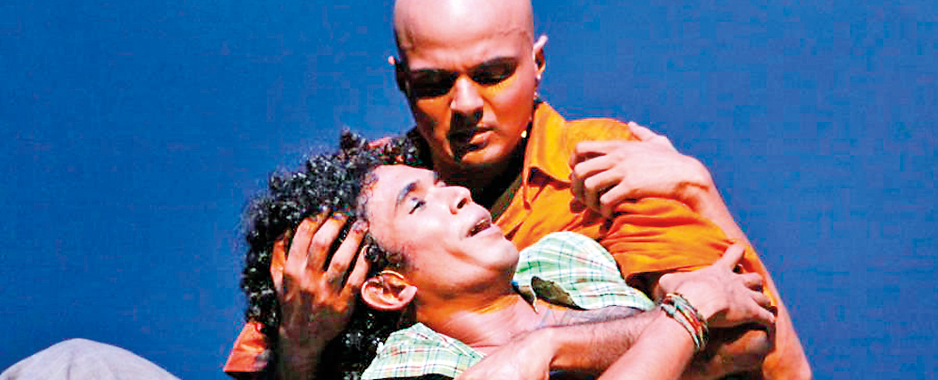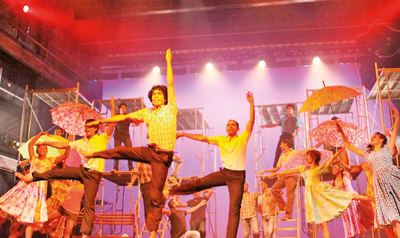Rag: Raw, energetic appeal against campus violence
I first saw this play in 2004 when it was in an embryonic stage. At the time, the production was very much a work-in-progress, with Rag as it was then being presented to local audiences on an experimental basis. Some fine-tuning was done in 2005, in which year this musical was reproduced and represented in a master-stroke of theatrical promotion. Now, eight years since its first showing and having germinated in Jehan Aloysius’s fertile theatre brain for well over a decade, Rag –The Musical looks like it is ready to take the region by storm. World premiere, as they call it, having been done and dusted by the time you read this…
But it is at home that this raw, edgy, and energetic drama will have the best – and hopefully most beneficial – impact. Because when you strip away all the hype and the hoopla (and there is quite a bit of that, believe me), Rag is a rare animal indeed: a musical with a social conscience. And in times like ours, when our education microcosm is going to hell in a hand-basket, such a production is dangerous; insidious; infectious.
We go to the theatre these days (on those rarer and rarer occasions when we do, whenever there’s anything worth being engaged by) because we want entertainment. Or because we think we do. But the reality in our increasingly tech-savvy environment is that there are vastly more entertaining things in the world outside than within the auditoria of our English-language theatre-starved city. So even when a production comes along that promises to attract and retain your attention for over two-and-a-half hours – the time it would take you to watch a blockbuster movie at home, dance your cares a part of the night away, eat a fellowship meal with family, call on a long-lost friend – you would be forgiven for hesitating to head to the box office. That Rag managed to fill the Wendt on five successive nights (two of these very rainy) – in the frothy wake of another musical that ran for a fortnight’s worth or so of shows – is to its credit.
The plot
Joseph, a pacifist dreamer (hmm… now where have we heard that one before?), gains admission to university. On campus he befriends Thomas – a, er, shall we say, merry and light-hearted young man – and many others amongst whom he begins to live out his dream in relative peace. But his childhood friend and present nemesis Peter is also there, a big wheel on campus who leads the raggers. (By now, you would have got the drift: Joe, Pete, and Tom are, of course, symbolic of the Colombo boys’ schools which sometimes supply varsity with its wits and half-wits…)

The rag, exacerbated by vicious young hoodlums like Harsha, a turncoat fresher, is violently opposed by Rukmal and his cohorts: political activists. Joseph prefers the power of words, until his sensitivities suffer more than a scratch below his sophisticated veneer of passive resistance. Compounding matters for Joe is not one love interest, but three; one of whom is Peter’s present inamorata, who is callously rejected by him after her rape by a trio of ragging thugs. Internecine warfare breaks out after Tom’s suicide following his humiliating hazing.
And the ensuing violence threatens friendships, presses rivalries to the limit, challenges visionaries and activists alike to take a stand – on principle and in person. For an otherwise fun-filled musical, the body count at the end is high… but though the dreamer pays the ultimate price, as dreamers generally do, the dream lives on in the vision and solidarity of the survivors. And their conviction of the stand taken against violence on campus is so convincing that audiences on several nights were moved to give them standing ovations.
The players
In a dizzyingly dynamic production where the athletes (sorry, I mean actors) are whirling, twirling, and tumbling about at any given time, it was hard for the eye to stay focused on the protagonists. This was one of the most energetic productions I have seen, not only in terms of the choreography (which was dazzling to someone with two left feet, like me), but also as regards the connectivity (the ensemble cast was always ‘on’, interacting even while the action was elsewhere, lending the play a real live-wire look and feel). That said, a few players stood out for me (you may have had your own favourites, O aficionados?). Jehan Aloysius as Joe was, dare I say as usual, simply brilliant; dancing, singing, and strutting without pause, carrying the others along with him without overshadowing them. Amandhi Caldera as Natasha, Peter’s ex, turned in a feisty little performance. Dilini Perera Fox as Sakuntala (or Sassy-Fatty, the butt of sundry jokes among the campus shrews) was strangely moving in her portrayal of a senior with freshman crushes and sympathies. But the revelation of the night was Damien Fernando as Tom: petulant in parts and potentially picaresque until his untimely death by his own hand, this character had audiences in stitches at the same time as his character held the tattered fabric of Rag in tension – until the veil was torn by his suicide.
The production
Rag has been the brainchild of one man, no doubt, but it has become the master project of a few other key contributors along its ten-year trajectory. The musical genius of Avanthi Perera (musician/orchestrator) from the outset, together with Deshan Cooray’s inspired choral arrangements and more recently the virtuosity of Eshantha Peiris, have lifted Rag from the rough and ready to the smooth and sophisticated. One other aspect that strikes observant audiences is that this gang – cast, crew, ‘catchers’ – is that it is a team that works well together and for whom the principle that the sum is greater than its parts holds true. Cuts and scrapes apart, the slick tenor of the acrobatics and lifts – “all the while singing” – attest to that…
The presentation
The scaffolding that passed for a set was what the programme liked to call ‘industrial’ and ‘utilitarian’, which you and I might say was ‘minimalist’. This was not out of laziness or lack of creativity (quite the opposite for the latter criterion), but to lend the staging a raw, edgy, metallic feel. Costume design being based on serge de Nîmes gave both wardrobe and overall visual ethos a rugged, realistic, timeless effect. Light was well used in silhouetting and shadow play, although players atop scaffolding were lost in the darkness (which may have been apposite, given that they were mostly the villains of the piece). Props of note included a thematically ragged curtain as front-drop/projection screen. A Pietà scene, the piece de resistance of previous incarnations, was toned down but still unmistakeably grave in its sombre timbre.
The point
In a day and age where romances interest café society, historical musicals hold sway, and farce is considered a tour de force, Rag was refreshingly different. It challenged audiences to get real about the zeitgeist outside their comfort zones, without short-changing them in the entertainment department. While the play had not been updated to reflect contemporary realities (for example: there were no references to the growing militarisation of the country’s campuses or academic strikes which are common today), its message is as relevant now as it was then and will no doubt be tomorrow. Until and unless ‘the power of one’ (one person’s principled stand) becomes ‘the might of some’ (a joint stand) and ‘the right of many’ (the re-establishment of law and order).

These imperatives have come out of the respective personal experiences of Jehan Aloysius and Avanti Perera and the real-life ‘Ali Gansiya’ that was ragged during their freshman year at university. We applaud them for the courage and creativity with which they have dramatically chronicled their individual traumas for the attention and action of us as a collective.
The positives
New faces, fresh talent, amazing passion for a cast so young! Being lithe and limber boosted the energy to higher levels than previously seen in this theatre group’s other efforts (Caliban’s Rebellion, Pyramus & Thisbe). Spotlight on the play within a play, fast becoming a CentreStage tradition, and always a good vehicle for Aloysius & Co. to introduce some scintillating high-jinks. It’s hard to do comedy well, but Rag succeeded in this mini-segment. Native dress forms, vernacular jokes, a litany of catchy songs and some memorable tunes, diverse dance styles – all these made Rag almost a revue: an embarrassment of riches?
The pitfalls
Not to quibble too much after such a delightful evening, but the dénouement was somewhat anticlimactic. For all its vim, vigour, and vitality, the play ends on a valiant but indecisive note. That may be its intention. For, the climatically sung appeal to the audience – you and I as we leave the auditorium and return to real life – to stand together as one against a dastardly social injustice, succeeds most where it most leaves unsatisfied. We are moved to tears because we know the cause is worthy and the price paid by those who face – and oppose – ragging on our campuses is high.
But once the catharsis is done, one goes away wondering whether the psychology of the play suffered for lack of a triumphant note at the end. Two of the protagonists die, one is scarred for life by rape, and several characters’ lives are turned upside down and inside out and right side wrong. But for all that, I would have liked to see a character within the drama unfolding so poignantly change his or her mind about the reality of the diametrically opposed stands taken on ragging. But no. The angels end as angels, the demons as demons. (Saku’s defection has a patina of self-interest.) What price repentance, a metamorphosis, a radical emergence of at least one of the bad guys as a new champion of social justice? (Dream on.)
The postscript
Next time Rag is on, don’t miss out on it in favour of the other ersatz song and dance routines that beckon and tempt. This is the real thing. Plus while you’re waiting for its reprise, how about a little reciprocity for the time and trouble taken by advocating against ragging? Come on: “Do it!”, “Do it!”, do your bit for theatre and education in Sri Lanka today!
Rag – The Musical |
Written, Directed, Designed, Composed, and Choreographed by Jehan Aloysius
Presented by CentreStage Productions
October 19-23 The Lionel Wendt Theatre, 7.30 p.m. daily.
Follow @timesonlinelk
comments powered by Disqus



























